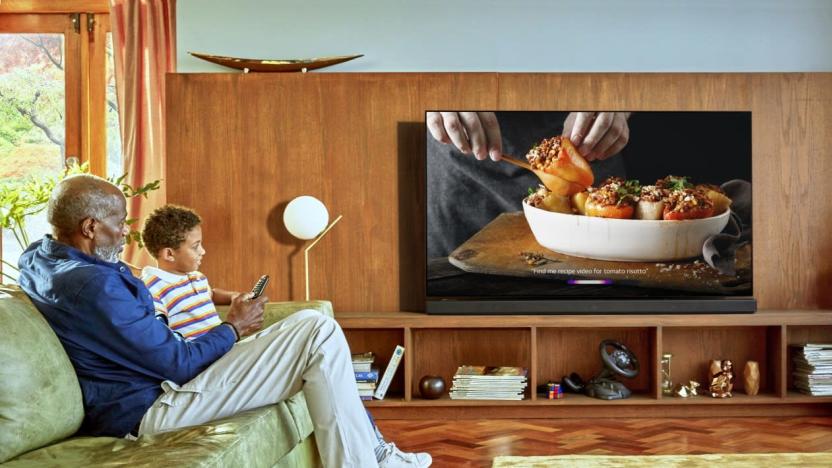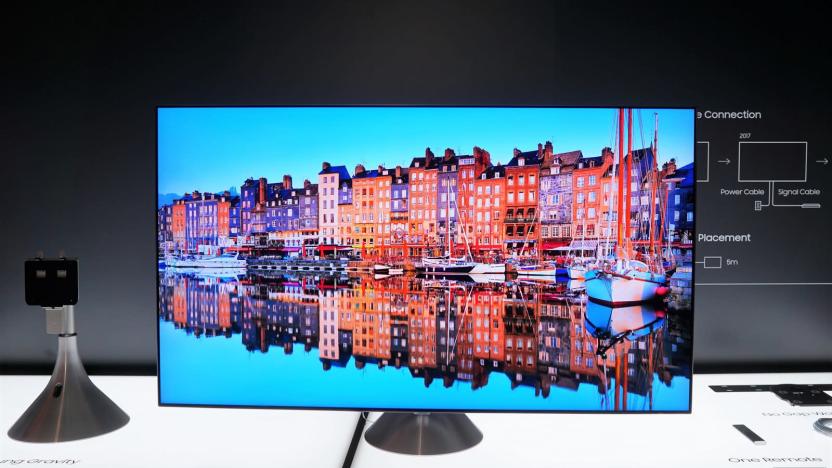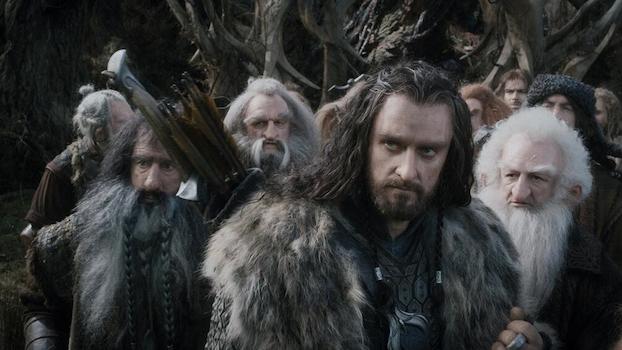HFR
Latest

Ang Lee chases cinema’s 120FPS future with ‘Gemini Man’
Ang Lee is curious. That's why the Oscar-winning director has spent the past decade fighting against the limitations of cinema -- 2D screens and the 24 frames-per-second standard -- instead of just making sure-fire hits. With Life of Pi, he dove into elaborate 3D filmmaking and creating life-like digital animals. After the global success of that film, he set his sights on Billy Lynn's Long Halftime Walk. That drama wasn't particularly well received by audiences or critics, but it allowed him to explore the uncanny realism of combining high framerates (HFR) of 120 FPS, together with 4K and 3D. Now with Gemini Man, Lee's latest film starring Will Smith (and his younger digital double), he's trying to bring his new vision of cinema to a mainstream action film.

You can see 'Gemini Man' in 120 fps or 4K, but not both
Ang Lee wants people to see his latest movie, Gemini Man, in 3D at 4K resolution and 120 frames per second. But it'll be a tough ask to watch the Will Smith thriller that way if you're in the US -- it seems no American theaters will project it in the director's intended format.

Paramount is urging theaters to show Ang Lee's new sci-fi movie at 120 fps
Ang Lee hasn't given up on high-frame-rate cinema despite the expensive misfire that was Billy Lynn's Long Halftime Walk. The two-time Oscar winner is shooting his upcoming film, sci-fi assassin thriller Gemini Man, in 3D at 120 frames-per-second (fps) and 4K resolution. There's just one problem: theater chains may not be able to screen it in the format. To ensure it gets a wide release that matches Lee's intended vision, Paramount is writing to cinema owners with instructions on how to bring their projector equipment up to speed, reports The Playlist.

LG's 2019 TVs add HDMI 2.1 and 8K
CES 2019 hasn't started yet, but LG is already drip-feeding information about this year's OLED and LCD TVs. While it didn't mention the rollable OLED we're expecting, it did list model numbers for two 8K sets, with an 88-inch Z9 OLED and SM99 8K LCD TV on the way. There's no word on price yet, but the big confirmation is that thanks to HDMI 2.1 ports, all of its 2019 OLED TVs and "selected" NanoCell LCD TVs will support high frame rate (HFR) 120fps video inputs. Other features in the new standard include an enhanced audio return channel (eARC) as well as variable refresh rate (VRR) and automatic low latency mode (ALLM) to keep gamers happy. If you're snagging one of the new 8K TVs, you'll just be pleased to know you won't have to plug in four HDMI cables to get everything connected. The NanoCell name is a new brand for LG's high-end LCD TVs (SM9X and SM8X) with enhanced color, viewing angles and thin bezels. As usual, LG is also talking up its AI capabilities with Thinq technology, and a new Prime Video button on its Magic Remote that ties in directly to Amazon's Alexa routines.

LG starts teasing 2019's OLED TVs
It must be close to CES time, because once again LG is talking about next year's TVs. In a post touting the Alpha processors that drive its various displays, it revealed that in 2019 its high-end OLED screens will include the Alpha 9 (α9 Gen 2), the sequel to last year's A9 CPU. It mentioned a four-step noise reduction process and support for high frame rate 120fps video (HFR). The only issue? They listed the same features last year. What we'd be really interested to find out is if these new TVs will have any support for the HDMI 2.1 standard. If they do, then it would be possible to input HFR video via HDMI -- last year's sets could only do it via a USB drive. Another big addition last year was support for AI like Google Assistant, and we'll need to see if that gets any upgrades in the new sets as well.

Ultra HD group outlines next generation of 4K TV broadcasts
The concept of 4K TV broadcasting is only just getting off the ground, but its overseers are already planning for what comes next. The Ultra HD Forum has published its first "Phase B" guidelines detailing what companies should aim for with future 4K broadcast tech. Not surprisingly, high frame rates should play a major role -- the group is hoping for 100FPS and 120FPS video (depending on the region) with a fallback for 60FPS. It's also pushing for dynamic HDR video through formats like Dolby Vision and SL-HDR, while Dolby AC-4 and MPEG-H would provide audio that could adapt from elaborate 3D sound setups to a plain set of headphones.

LG gears up for high frame rate 4K sports broadcasts
A few years ago, high frame-rate was a big talking point for movies. Director Peter Jackson bet big on it with his version of The Hobbit, but since then interest has died down mostly due to audience pushback against the unnaturally clear images it presents. While HFR might not work best with film, there's the chance that it'd be a good fit for broadcast TV and sports -- formats where we're already used to watching faster frame-rates. At least that's what LG is hoping for. The electronics company has partnered with satellite operator SES to demo 4K HFR broadcasts this week in Luxembourg.

James Cameron: High frame-rate cinema is 'a tool, not a format'
Sadly, James Cameron is going to probably retire making Avatar sequels that focus more on technology than story or his trademark action-flick set-pieces. Armed with $2.8 billion in box office receipts from the first movie, Cameron's been on a technology sojourn. He's been extremely vocal about his support for high frame-rate (HFR) cinema and stereoscopic 3D for filmmaking in the past, but it seems like he's changing his tune slightly these days.

Ultra HD Blu-ray will have 4K discs here in time for the holidays
After locking down a name, logo and spec, the Blu-ray Disc Association has announced it's just about ready to start licensing the Ultra HD Blu-ray technology. The group anticipates we'll hear about products for the 2015 holiday season (and naturally is revealing this right after Western Digital's 4K movie ready hard drive appeared). Coming around just about nine years after the first Blu-ray players arrived, this upgrade is about more than just high-res 4K (3,840 x 2,160) video -- it also includes support for high dynamic range (HDR), high framerate (HFR) and a "digital bridge" feature that should give viewers more ways to store and play their movies, even while keeping the disc on the shelf.

Ultra HD Blu-ray is bringing high-res movies home soon
After Blu-ray and HD DVD ushered in the age of HD and 1080p movies for the masses, discs were beaten to 4K by streaming services like Netflix, YouTube and Amazon. While the internet is still doing most of the heavy lifting for 4K, the Ultra HD Blu-ray specification is finally complete which means we should see movies and players arriving later this year. Besides being compatible with the 10,000~ Blu-ray discs already out, Ultra HD Blu-ray players will be ready for high-res 3,840 x 2,160 video, "next generation object-based sound formats" (think DTS: X and Dolby Atmos), more colors, high dynamic range (HDR) and even high frame rate video. That's a lot of buzzwords to say movies will have the capability to look and sound better at your home than they ever have before. The BDA also made vague reference to a "digital bridge" setup for extending your movie purchased on a disc to other devices like phones and tablets, but didn't say exactly how that will work, or if it's going to be any better than Ultraviolet.

Disney Research's trippy tale of immortality is ready to watch
We didn't expect Disney Research to have one of the more inventive uses of YouTube's crazy frame-rate capabilities, but here we are. The outfit's released its trippy Lucid Dreams of Gabriel short via Google's video wing and, despite it being around four months late, the filmmaking techniques are impressive in their finished form. As a quick refresher, the clip combines novel computational shutters, multiple frame rates within the same shot and high-dynamic range tone mapping to achieve its surreal look. But, in the context of a short film they distract from the story (however hippie-dippy it may be) and make Gabriel seem more like a tech demo than an actual, structured narrative; the tricks do more to call attention to themselves than they do support the action onscreen.

The Desolation of Smaug shows Peter Jackson still hasn't perfected HFR
Peter Jackson's introduction of high frame-rates (HFR) in Hobbit: An Unexpected Journey caused him an unexpected headache: many filmgoers hated the new tech. Those folks found that the hyper-realistic screenings ruined the magic, while others like myself enjoyed the eyestrain-free 3D experience and felt it should be given a chance, despite some issues. Because of all that, Jackson decided to tone down the too-sharp images for the HFR version of The Desolation of Smaug to make it more filmic and please critics and fans alike. With that in mind, I went to an HFR screening as an unabashed 3D buff, hoping to be absorbed by the story and not distracted by the tech. Unfortunately, it didn't quite happen that way.

Peter Jackson promises improved high frame rate showing for The Hobbit: The Desolation of Smaug
The first Hobbit movie served as a debut for 48fps "high frame rate" movies, and found a cool reception from critics and many fans. This time around, as The Hobbit: The Desolation of Smaug hits theaters, director Peter Jackson is doubling down on the rhetoric, claiming that an improved HFR is the best way to see the movie. Quoted by Variety, Jackson repeated claims that this new process improves the quality of 3D, and says he experimented with a different approach to color grading that takes away from the HD-ish look many disliked the first time around. The second Hobbit movie has HFR screenings at 812 screens, nearly double the last year's number. This time around press and critics saw the film in 24fps, instead of 48fps, but the various premieres did feature HFR showings. By now some of you have either seen the movie or are going to a screening this weekend, let us know if you picked the super-smooth 48fps showing or stuck with old school 24fps projection.

Ask Engadget: best slow-motion camcorder for around $200?
We know you've got questions, and if you're brave enough to ask the world for answers, then here's the outlet to do so. This week's Ask Engadget inquiry is from Philip, who wants to document his son's baseball adventures. If you're looking to ask one of your own, drop us a line at ask [at] engadget [dawt] com. I'm looking for a HFR camcorder, as I like to record my son playing baseball and play it back in slow motion. The Kodak PlayFull looked like the solution, offering 120fps at 1,280 x 720 for $200, but then Kodak axed its camera businesses and it never made it to market. What other options, therefore, exist for 120fps video recording around a similar price bracket? To be honest, slow-motion recording at such a low price is going to mean you'll only be able to get pictures at dreadful resolutions. If you're happy with footage at 640 x 480, then you could snag a Canon Powershot S100, but even that comes in at $319 from Amazon right now. It's a shame your budget couldn't stretch to $1,000, as we're desperate to find out if JVC's Procision is worth the hype. It's at this point that we should probably turn this over to the Engadget community and get them to share their wisdom -- so join in, HFR fans.

Advanced ticket sales for The Hobbit start, 450 theaters are ready for 48 fps 3D
Even if you aren't a Peter Jackson fan, you might still be interesting in seeing what all the fuss is about regarding the latest theater technology, 48 fps. It shouldn't be too hard either, because while the high frame version of The Hobbit: An Unexpected Journey is a limited release, the 450~ locations planned (out of approximately 4000 theaters showing the flick) cover just about every major and mid-sized city in the US. Regal and AMC theaters might be your best bet as they lead the pack in LA, with 19 theaters there ready for the new technology. Advanced ticket sales are already available for the December 14th release, but you'll want to look for 'HFR' or the words High Frame Rate before check out, if you want to see it the way Peter Jackson intended. If things go well, you can expect a much wider release of the 48 fps version of the sequel, which is already set to hit theaters in December 2013. Update: There's an official list of HFR equipped theaters on The Hobbit website, click here or check it out after the break to find one in your neck of the woods.

Sony teases '4K, HFR' F-series pro camcorder for October 30th event
Sony recently teased its high-end CineAlta brand and 'TheNewF,' implying a high-end PMW-F3-like camcorder could be coming at an October 30th event. It's now taken some of the suspense out of the announcement on Facebook, saying the upcoming camera will have 4k resolution, broadcast-level 50Mbps data rate, 4:2:2 color space and high frame-rates. That means it'll likely be a professional product on par with the last F-model, but we'll have to wait and see if it'll retain features like the PL lens mount and $16k price tag. We'll be there on the 30th for the full scoop, so stay tuned.

Comic-Con fans go crazy over Hobbit teaser, but not the 48fps version
Two different audiences and two very different screenings. After unfamiliar 48fps Hobbit footage was pretty universally panned back at Cinema-Con, Peter Jackson decided to play it safe and show Comic-Con fans the traditional low frame-rate teaser. Their response? They loved it. Which would, you'd think, give the head hobbit a clear message: his film works better without the wacky frame rate, but that's just not how he sees it. Writing on his Facebook page, he said "I've always been happy to bet on myself" and the 48fps version of Hobbit is "something really special" when you watch the entire movie. In other words, he's sticking to his orc sword, and in the meantime we're left to wonder what would have happened if the Comic-Con crowd -- who are perhaps more his kind of people than Cinema-Con goers -- had been shown the tricked out footage.

Editorial: Despite shaky 48 fps Hobbit preview, high frame rates will take off
Well actually, the Hobbit preview wasn't shaky, it was smooth -- maybe too smooth -- and that's the point. "It does take you a while to get used to," Peter Jackson has admitted, referring to the surprisingly fluid motion of his 48 fps movie footage. But is he right to think audiences will even give it a chance? The launch of high frame-rate (HFR) cinema is surrounded by publicity in the run-up to the Hobbit's debut on December 12th, but it equally has a lot going against it. For starters, the film's 48 fps preview wasn't exactly received warmly. On top of that, the video-style appearance of HFR has a long history of being disliked by movie-goers -- past attempts since the 1970s have all flamed out. 85 years after the first 24 fps movies, the same number of frames are still going stubbornly through the gate (digital or otherwise) each second, so that must be what "filmic" is, right? Or will we look back on 24fps as the bad old days? Read on to see if these new/old-fangled frame speeds might survive, and though a 48 fps Hobbit trailer isn't available, we've provided a couple of clips to help you judge what two-dimensional HFR looks like.








